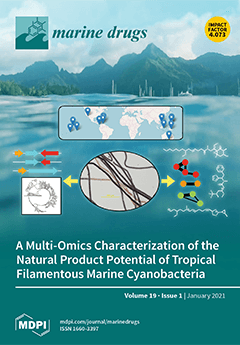Chemical investigation of a Red Sea
Spongia sp. led to the isolation of four new compounds, i.e., 17-dehydroxysponalactone (
1), a carboxylic acid, spongiafuranic acid A (
2), one hydroxamic acid, spongiafuranohydroxamic acid A (
3), and a furanyl trinorsesterpenoid
[...] Read more.
Chemical investigation of a Red Sea
Spongia sp. led to the isolation of four new compounds, i.e., 17-dehydroxysponalactone (
1), a carboxylic acid, spongiafuranic acid A (
2), one hydroxamic acid, spongiafuranohydroxamic acid A (
3), and a furanyl trinorsesterpenoid 16-
epi-irciformonin G (
4), along with three known metabolites (−)-sponalisolide B (
5), 18-nor- 3,17-dihydroxy-spongia-3,13(16),14-trien-2-one (
6), and cholesta-7-ene-3β,5α-diol-6-one (
7). The biosynthetic pathway for the molecular skeleton of
1 and related compounds was postulated for the first time. Anti-inflammatory activity of these metabolites to inhibit superoxide anion generation and elastase release in
N-formyl-methionyl-leucyl phenylalanine/cytochalasin B (fMLF/CB)-induced human neutrophil cells and cytotoxicity of these compounds toward three cancer cell lines and one human dermal fibroblast cell line were assayed. Compound
1 was found to significantly reduce the superoxide anion generation and elastase release at a concentration of 10 μM, and compound
5 was also found to display strong inhibitory activity against superoxide anion generation at the same concentration. Due to the noncytotoxic activity and the potent inhibitory effect toward the superoxide anion generation and elastase release,
1 and
5 can be considered to be promising anti-inflammatory agents.
Full article






